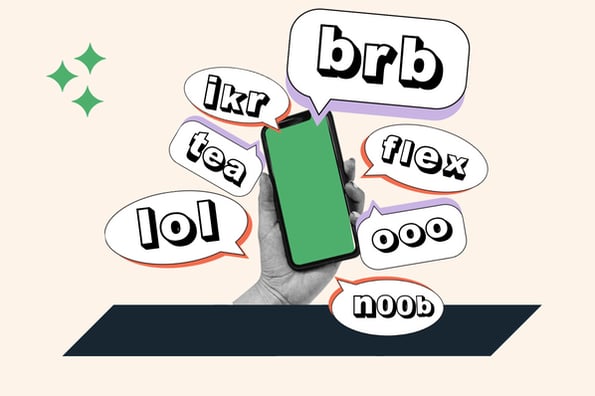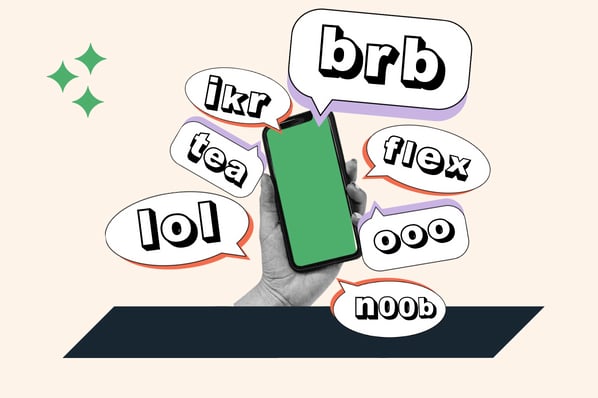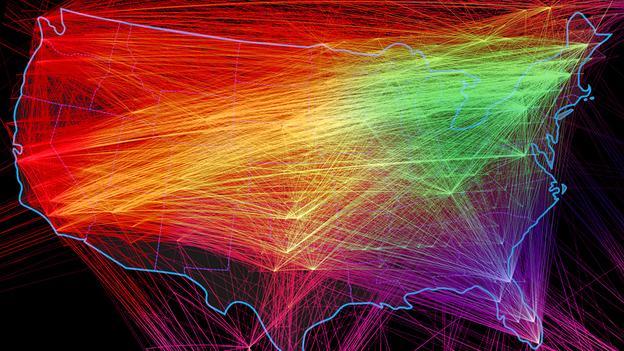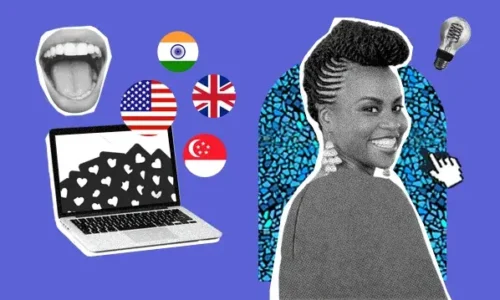
81 Terms To Know About
- August 29, 2023
- Knowledge Base
- 0 Comments

Internet slang spreads like wildfire and sometimes seems to come out of nowhere. Some are short-lived, some are used in niche communities, but some go so far as to be included in dictionaries.

Whether you spend time online as a casual user or a marketer enacting a social media strategy, you want to know what different slang and abbreviations mean.
In this post, we’ll discuss how internet slang originates and spreads, define 81 slang words you might come across, and outline what it takes for slang to be added to our dictionaries.
Table of Contents
Is the Internet to Blame?
As we spend less time listening to the radio or watching TV and more time online, the latter has the most influence on our day-to-day dialogue.
The fast pace of the internet also means we adopt words much faster than ever before. “Language itself changes slowly, but the internet has sped up the process of those changes so you notice them more quickly,” David Crystal, honorary professor of linguistics at the University of Bangor, told BBC News. You can imagine how much longer it took new words to spread through word-of-mouth than it does today with the internet.
How Slang Spreads on the Internet
Linguistics and anthropologists have studied how slang spreads for decades, but it was only possible to measure with precision once public social media networks emerged.
Platforms help linguists accurately and easily search and record language exchanges. For example, Jacob Eisenstein and his colleagues at the Georgia Institute of Technology examined 30 million tweets from the U.S. to pinpoint the origin of popular slang words and their spread. The image below is the resulting map that shows how terms migrated and their direction of influence.

Slang now moves around within weeks and months instead of years, says Julia Coleman, author of The Life of Slang. “It’s not necessarily that language is changing more quickly, but technologies have developed and they allow the transmission of slang terms to pass from one group to another much more quickly.”
Internet Slang Around the World
The internet impacts the development of language all across the world.
In Ukraine, Svitlana Pyrkalo says the force-quit process of pressing control+alt+delete is known as Дуля (dulya). A dulya is a Ukranian gesture using two fingers and a thumb, used in the same situations in which we‘d give “the finger.” “And you need three fingers to press the buttons,” says Pyrkalo. “So it’s like telling somebody, a computer in this case, to get lost.”
Other countries have their own versions of “LOL.” In France, “mdr” stands for “mort de rire,” meaning dying of laughter. The Swedish write “asg” as an abbreviation of Asgarv, meaning intense laughter. The number 5 in Thailand signifies the letter “h,” so 555 is “hahaha.”
It’s important to note that a lot of popular internet slang comes from African-American Vernacular English (AAVE), a form of English spoken by Black Americans. Often, Black people have conversations online, other people use the words, and they become part of everyday internet speak.
With all of this in mind, let’s review some of the most popular internet slang words, many of which are acronyms and others full words and phrases.
Internet Slang Words
General Internet Slang
1. Acct
Acct is short for account.
2. BC
BC stands for because.
3. Bet
Bet has multiple meanings, one being a simple “yes” or a response of agreement, but it can also mean “It’s on” as a response to something you don’t believe is true.
For example, someone says, “I can do this better than you,” and someone responds, “Alright, bet.”
4. BRB
BRB stands for be right back.
5. BTW
BTW stands for by the way.
6. Down
Down means “yes,” or a response demonstrating that you’re up for or interested in something.
For example, “Who wants to go to the movies?” “Down.”
7. Flex
Flex means showing off. Occasionally people say, “Weird flex but ok,” to react to someone showing off or bragging about something in poor taste.
8. FOMO
FOMO stands for fear of missing out, and i’ts used when someone is worried about not being invited somewhere or isn’t part of an experience.
It’s also used as an active verb, like “Everyone’s at the concert, and I’m having FOMO.”
9. FYI
FYI stands for your information.
10. Goat
Goat means greatest of all time. People also say goated to mean the same thing. For example, “Messi is the goat,” or “Messi is goated.”
11. GTG or G2G
GTG and G2G stand for got to go.
12. Highkey
Highkey describes something glaringly obvious and true that doesn’t need to be hidden. It’s the opposite of lowkey.
For example, “That was highkey the best meal I’ve ever had,” or “I highkey need tickets to the show.”
13. IKR
IKR stands for I know, right?
14. IMHO
IMHO stands for in my honest opinion or in my humble opinion.
15. IRL
IRL stands for in real life.
16. Iykyk
Iykyk stands for “If you know, you know,” and it’s a descriptor for an inside joke or something niche that applies to a specific group of people.
17. JK
JK stands for just kidding.
18. JOMO
JOMO stands for joy of missing out, and it’s used when someone is unbothered by not being invited somewhere/missing an experience or is happy because they weren’t interested to begin with. The opposite of FOMO.
19. K
K means okay, but is also used when someone is frustrated and is putting an end to a conversation.
20. L
L means loss or loser, and it’s usually said when someone has failed at something or a situation hasn’t gone their way, like “I took an L last night.”
If people don’t agree with something they see online, they might comment “L” to convey their point.
21. LMK
LMK stands for let me know.
22. LOL
LOL stands for laugh out loud.
23. Lowkey
Lowkey has multiple meanings.
- When someone is slightly or moderately bothered by something, but it isn’t a big deal: “I’m lowkey sad I missed the show, but there’s always next time.”
- When something should be kept secret, discreet, and not shared outside of the conversation: “Lowkey, I might quit.”
- To describe a mellow or low-stakes situation: “It was a lowkey party with my closest friends.”
24. Mid
Mid means average or below average. It’s usually a dig at someone or something, like, “That movie was mid.”
25. NBD
NBD stands for no big deal.
26. OOTD
OOTD stands for outfit of the day.
27. Photobomb
Photobomb means entering someone’s picture or video uninvited, usually on purpose.
28. Prolly
Prolly is slang for probably.
29. Salty
Salty means upset or bothered.
30. TFW
TFW stands for that feeling when.
31. TBH
TBH stands for to be honest.
32. TL;DR
People use it before giving a summary when telling a story or sharing information. People also comment TL;DR to say they won’t read something because it’s too long.
33. TGIF
TGIF stands for thank god it’s Friday.
34. TMI
TMI stands for too much information.
35. Troll
A troll is someone who purposely sparks controversy on the internet. Someone might say, “Ignore that comment; he’s just a troll.”
36. W
W stands for win, and it’s used when someone has won something, or something good has happened, like “How was your game last night?” “It was great we got the W!”
The opposite of L.
Social Media Internet Slang
1. AMA
AMA stands for asking me anything. It originated on Reddit, where someone well-known has an AMA session where forum audiences can submit questions for them to answer.
2. Anon
Anon is short for anonymous.
3. ASMR
ASMR stands for autonomous sensory meridian response, and it’s any video or audio content that provides a relaxing and satisfying feeling to viewers.
4. Bot
A bot is an account that shares spammy and unwanted content or a person who shares unwanted content or is bad at something.
5. Bump
Someone says “Bump” to push a comment or post back to the forefront of a thread or comment section.
6. Caught in 4K
Caught in 4K means to catch someone red-handed.
7. DM
DM stands for direct message.
8. Doomscrolling
Doomscrolling describes spending endless time scrolling through your social media feeds, usually through grim news stories.
It can also mean getting stuck scrolling through content for a significant amount of time.
9. FB
FB stands for Facebook.
10. Handle
A handle is a username on any social media.
11. Hashtag
Hashtag (#) is a way that people find content on social media. Sometimes people say hashtag out loud in an ironic manner, like “Hashtag yummy” while eating.
12. Icon
An icon is a picture on social media, usually a profile picture.
13. IG
IG stands for Instagram.
15. Lurker
A lurker is active on social media or specific channels but never comments or participates in the conversation.
16. N00b
N00b is slang for newbie, and it’s a descriptor for someone who is a beginner or new to something. People call themselves a n00b, and saying it to someone else means they’re ignorant or bad at something.
It’s also spelled noob or newb.
17. OP
OP stands for original poster, and it’s the person who started a conversation on social media or was the first to share something.
18. QRT
QRT stands for quote retweet, and it’s when someone reshares a Tweet to their profile and adds their commentary above it.
19. Ratio/Ratioed
Ratio and ratioed are used as a dig when someone doesn’t agree with what someone has said. They might comment “Ratio” with full confidence that they’ll get more likes than the original post because more people agree with them.
20. RT
RT stands for retweet, and it’s when you reshare someone else’s Tweet to your timeline.
21. @me
@me is typically used when someone sees something someone has said, assumes it’s about them, and tells the original poster to tag them directly.
22. Shook
Shook means to be extremely shocked by something or an experience you’ve had.
23. Spam
Spam is content shared on social media that is annoying and unwelcome.
24. Stan/stanning
Stan means fiercely supporting someone or something
25. TBT
TBT stands for throwback Thursday.
26. Tea
Tea is gossip. When people share it, it’s called “Spilling the tea,” or people may say, “What’s the tea?”
27. TW
TW stands for Twitter.
28. Vibe
Vibe has multiple meanings. It can describe chilling (relaxing), or how a situation might feel.
Someone might say, “What’s the vibe?” or “This gives me a good vibe,” or “I’m vibing right now.”
29. Vibe check
Vibe check is a question people ask to see how someone is feeling or how a current situation is going.
Business Internet Slang
1. ASAP
ASAP stands for as soon as possible.
2. YT
YT stands for YouTube.
3. B2B
B2B stands for business to business.
4. B2C
B2C stands for business to consumer.
5. CTA
CTA stands for call to action.
6. DNB
DNB stands for do not book, meant to specify a timeframe when you aren’t available for meetings.
7. EOD
EOD stands for end of day.
8. EOW
EOW stands for end of week.
9. FAQ
FAQ stands for frequently asked questions.
10. MOM
MOM stands for month over month.
11. OOO
OOO stands for out of office.
12. TBA
TBA stands for to be announced.
13. WFH
WFH stands for work from home.
14. WOM
WOM stands for word of mouth.
15. YOY
YOY stands for year over year.
16. Zoombomb/Zoombombing
Zoomboming is a disruption to a Zoom meeting by someone who hasn’t been invited to the meeting.
How New Words Make It Into the Dictionary
Once new words have grown and become part of the general lexicon, how do acronyms like “LOL” make it to the dictionary? Longevity.
To make it into the dictionary, the general population must use it and keep using it. Fiona McPherson, Senior Editor, Oxford English Dictionary, says five years is a good length to become eligible for a spot in the big book.
Dictionary editors also look to us when voting on whether a word should have a place in their dictionary. “Dictionaries are fantastic resources, but they are human and they are not timeless,” Language Historian Anne Curzan reminds us. “If you ask dictionary editors, what they‘ll tell you is they’re just trying to keep up with us as we change the language. They‘re watching what we say and what we write and trying to figure out what’s going to stick and what’s not going to stick.”
So, no matter whether you think internet slang vitalizes or destroys language, there’s no denying how revealing it is of the culture that invents and uses it — and the ease with which we adapt our language to new technologies and concepts.





